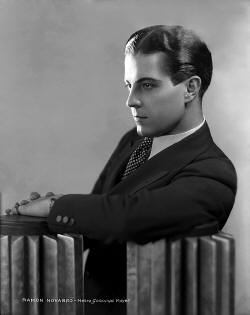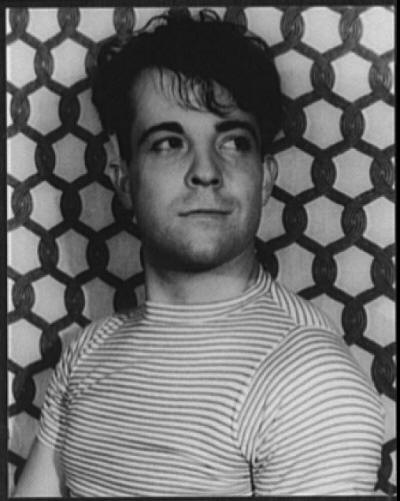
Partner Herbert Howe
Queer Places:
3110 Laurel Canyon Blvd, Studio City, CA 91604
Samuel-Novarro House, 2255 Verde Oak Dr, Los Angeles, CA 90068, USA
Calvary Cemetery, 4201 Whittier Blvd, Los Angeles, CA 90023, Stati Uniti
 Jose Ramón Gil Samaniego[1] , best known as Ramón Novarro (February 6, 1899 - October 30, 1968), was a Mexican film, stage and television actor who began his career in silent films in 1917 and eventually became a leading man and one of the top box office attractions of the 1920s and early 1930s,
while he was the lover of popular Hollywood news writer
Herbert Howe. Novarro was promoted by MGM as a "Latin lover" and became known as a sex symbol after the death of Rudolph Valentino.
Jose Ramón Gil Samaniego[1] , best known as Ramón Novarro (February 6, 1899 - October 30, 1968), was a Mexican film, stage and television actor who began his career in silent films in 1917 and eventually became a leading man and one of the top box office attractions of the 1920s and early 1930s,
while he was the lover of popular Hollywood news writer
Herbert Howe. Novarro was promoted by MGM as a "Latin lover" and became known as a sex symbol after the death of Rudolph Valentino.
Novarro was born José Ramón Gil Samaniego on February 6, 1899 in Durango City, Durango, Mexico, to Dr. Mariano N. Samaniego, and his wife, Leonor (Gavilan).[2] The family moved to Los Angeles, California, to escape the Mexican Revolution in 1913.[3] Novarro's direct ancestors came from the Castilian town of Burgos from where two brothers emigrated to the New World in the seventeenth century.[4]
Allan Ellenberger, Novarro's biographer, writes: "[...t]he Samaniegos were an influential and well-respected family in Mexico. Many Samaniegos had prominent positions in the affairs of state and were held in high esteem by the president. Ramon's grandfather, Mariano Samaniego, was a well-known physician in Juarez. Known as a charitable and outgoing man, he was once an interim governor for the State of Chihuahua and was the first city councilman of El Paso, Texas... Ramon's father, Dr. Mariano N. Samaniego, was born in Juarez and attended high school in Las Cruces, New Mexico. After receiving his degree in dentistry at the University of Pennsylvania, he moved to Durango, Mexico, and began a flourishing dental practice. In 1891 he married Leonor Pérez-Gavilán, the beautiful daughter of a prosperous landowner. The Pérez-Gaviláns were a mixture of Spanish and Aztec blood, and according to local legend, they were descended from Guerrero, a prince of Montezuma."[5]

by Carl Van Vechten
In 1927, writing the "life story" of Novarro for Motion Picture magazine,
Howe would admit that "biography should be impersonal. This isn't." Howe
couldn't manage objectivity when it came to Ramon: "friend and advisor, I've
known Novarro for four years and I still admire him." He did not shy away from
the obviously romantic description of their shipboard friendship. "I must have
touched a secret spring to his confidence," he wrote, "for that evening was
one of charmed revelation."
Novarro appeared with Norma Shearer in ''The Student Prince in Old Heidelberg'' (1927) and with Joan Crawford in ''Across to Singapore'' (1928).
In The Student Prince, Ernst Lubitsch reportedly plucked a good-looking and
obviously gay extra for Novarro to hug, sing, and laugh with in a crowd scene,
playing up the chrage between them. The scene, unfortunately, was cut.
He made his first talking film, starring as a singing French soldier, in ''Devil-May-Care'' (1929). He starred with Dorothy Janis in ''The Pagan'' (1929), with Greta Garbo in ''Mata Hari'' (1931), with Myrna Loy in ''The Barbarian'' (1933) and opposite Lupe Vélez in ''Laughing Boy'' (1934).
In the 1930s in Mexico, physicians, teachers, accountants, journalists and
other professionals stood to lose more than their clientele if exposed as
homosexual in the press, as such exposure would result in banishment to the
Islas Marıas Penal colony. Poet Salvador Novo and playwright
Xavier Villaurrutia sought
to join other Mexican sexiles in the United States or Europe, including
artists José Mojica,
Ramón Novarro,
Roberto Montenegro,
Agustın J. Fink and
Enrique Asunsolo, or scientists
studying abroad, like Elías Nandino and
Raoul Fournier. Seeking ‘to avoid a
fate as a cook, waiter, or dishwasher in New York’, Villaurrutia accepted a
one-year fellowship at Yale in 1935–36, while a frantic Novo wrote to
Federico García Lorca, asking him to procure him lodgings in Madrid.
If condominiums and apartments attracted middle-class gays, wealthier men were
seduced by the social possibilities large manses afforded them. Located in quaint,
cobblestoned, suburban colonial towns like San Angel and Coyoacan, manses enabled
cabinet members and wealthy professionals to lead anonymous, quiet lives in homes
set back amid vast walled gardens.
Luis Montes de Oca, Minister of Revenue, and
Genaro Estrada, Minister of Foreign Affairs, lived in compounds where they hosted
pool parties for handsome gay men, notably actors and film producers
Ramón Novarro,
José Mojica, Felipe Subervielle and
Agustin J. Fink. Estrada’s home held
prized homoerotic objets, like a four-poster bed with life-size male statues – replicas
of the famed Medici tombs in Florence. Montes de Oca constantly remodelled
his colonial manse, knocking down walls to exhibit his antiques better. Living with a
single male servant, Montes de Oca regarded himself as the guardian of San Angel,
spurring his neighbours to maintain the neighbourhood’s architectural unity. Genaro
Estrada’s home in Las Lomas was featured in society magazine Social, as a backdrop
to photographs depicting the wife he married prior to accepting a cabinet post, a tactic
that Jaime Torres Bodet later emulated when he accepted his first ministerial appointment in
1943. Estrada’s mother and sisters lived in his large home with his wife and daughter.
Estrada did not spend much time at home, preferring instead to hang out in restaurants,
cafes and bookstores, or in the homes of gay couples like
Antonio Adalid Pradel and
Antonio Dodero.
After a day of work, he would meet friends to discuss books and politics at Robredo’s
bookstore, then dine at Prendes, a Spanish restaurant where he hosted intimate
dinners, before retiring home. Estrada – who as a result of his obesity, suffered from
high-blood-pressure – spent most weekends in Cuernavaca, whose lower elevation benefited
his weak heart. There, he would invite male friends to accompany him, among
them exiled Spanish intellectual
José Moreno Villa.
When Novarro's contract with MGM Studios expired in 1935 and the studio did not renew it, Novarro continued to act sporadically, appearing in films for Republic Pictures, a Mexican religious drama, and a French comedy. In the 1940s, he had several small roles in American films, including ''We Were Strangers'' (1949), directed by John Huston and starring Jennifer Jones and John Garfield. In 1958, he was considered for a role in the television series ''The Green Peacock'', with Howard Duff and Ida Lupino, after their CBS Television sitcom ''Mr. Adams and Eve'' (1957–58). The project, however, never materialized. A Broadway tryout was aborted in the 1960s. Novarro kept busy on television, appearing in NBC's ''The High Chaparral'' as late as 1968.
At the peak of his success in the late 1920s and early 1930s, Ramón Novarro was earning more than US$100,000 per film. He invested some of his income in real estate, and his Hollywood Hills residence is one of the more renowned designs (1927) by Lloyd Wright, the son of Frank Lloyd Wright.[10] When his career ended, he was still able to maintain a comfortable lifestyle.
Novarro was troubled all his life by his conflicted feelings toward his Roman Catholic religion and his homosexuality.[11] His life-long struggle with alcoholism is often traced to these problems.[12] [13] [14] In the early 1920s, Novarro had a romantic relationship with composer Harry Partch, who was working as an usher at the Los Angeles Philharmonic at the time, but Novarro broke off the affair as his acting career began to become successful.[15] MGM mogul Louis B. Mayer reportedly tried to coerce Novarro into a "lavender marriage", which he refused.[16] He was romantically involved with journalist Herbert Howe, who was also his publicist in the late 1920s,[17] and with a wealthy man from San Francisco, Noël Sullivan.[18]
Along with Dolores del Río, Lupe Vélez and James Cagney, Novarro was accused of promoting Communism in California. It happened after they attended a special screening of the film ''¡Que viva México!'' by famed Russian filmmaker Sergei M. Eisenstein.
Novarro was murdered on October 30, 1968, by brothers Paul and Tom Ferguson, aged 22 and 17, who called him and offered their sexual services. He had in the past hired prostitutes from an agency to come to his Laurel Canyon home for sex, and the Fergusons obtained Novarro's telephone number from a previous guest.[19] [20] [21]
According to the prosecution in the murder case, the two young men believed that a large sum of money was hidden in Novarro's house. The prosecution accused the brothers of torturing Novarro for several hours to force him to reveal where the non-existent money was hidden. They left the house with $20 they took from his bathrobe pocket. Novarro died as a result of asphyxiation—having choked to death on his own blood after being beaten.[22] The two perpetrators were caught and sentenced to long prison terms, but released on probation in the mid-1970s. Both were later re-arrested for unrelated crimes for which they served longer prison terms than for the murder of Novarro.[23] Scotty Bowers' 2012 autobiography ''[[Full Service: My Adventures in Hollywood and the Secret Sex Lives of the Stars]]'' provides questionable details about Novarro's death.[24] In a 1998 interview, Paul Ferguson finally assumed the blame for Novarro’s death.[25]
Ramón Novarro is buried in Calvary Cemetery, East Los Angeles, California.[26] Ramón Novarro's star on the Hollywood Walk of Fame is at 6350 Hollywood Boulevard.
Novarro's murder served as the basis for the short story by Charles Bukowski called ''The Murder of Ramon Vasquez'', as well as for the song "Tango," by Jerry Leiber and Mike Stoller, recorded by Peggy Lee on her ''Mirrors'' album.
Novarro's murder is among the many epochal events recalled in Joan Didion's meditative 'California zeitgeist' essay The White Album.
In late 2005, the Wings Theatre in New York City staged the world premiere of ''Through a Naked Lens'' by George Barthel. The play combined fact and fiction to depict Ramon Novarro's rise to fame and his relationship with Hollywood journalist Herbert Howe.
Novarro's relationship with Herbert Howe is discussed in two biographies: Allan R. Ellenberger's ''Ramón Novarro'' and André Soares's ''Beyond Paradise: The Life of Ramón Novarro.''
Prize-winning Greek playwright Pavlos Matesis wrote a play in two parts titled "The Ghost of Mr. Ramon Novarro", which was first staged at the National Theatre of Greece in 1973.[27]
My published books:


BACK TO HOME PAGE

- ^ Ramon Novarro, From Wikipedia, the free encyclopedia
- Behind the Screen: How Gays and Lesbians Shaped
Hollywood, 1910-1969, William J. Mann, 2001
- The Transnational Homophile Movement and the Development of
Domesticity in Mexico City’s Homosexual Community, 1930–70, by Vıctor M.
Macıas-Gonzalez


 Jose Ramón Gil Samaniego[1] , best known as Ramón Novarro (February 6, 1899 - October 30, 1968), was a Mexican film, stage and television actor who began his career in silent films in 1917 and eventually became a leading man and one of the top box office attractions of the 1920s and early 1930s,
while he was the lover of popular Hollywood news writer
Herbert Howe. Novarro was promoted by MGM as a "Latin lover" and became known as a sex symbol after the death of Rudolph Valentino.
Jose Ramón Gil Samaniego[1] , best known as Ramón Novarro (February 6, 1899 - October 30, 1968), was a Mexican film, stage and television actor who began his career in silent films in 1917 and eventually became a leading man and one of the top box office attractions of the 1920s and early 1930s,
while he was the lover of popular Hollywood news writer
Herbert Howe. Novarro was promoted by MGM as a "Latin lover" and became known as a sex symbol after the death of Rudolph Valentino.